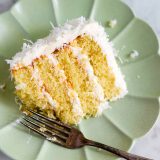Boasting four tender, airy layers, blanketed with buttercream and a blizzard of coconut, Margaret Newborn’s coconut layer cakes were towering, delicious affairs. So much so, even 30 years since her granddaughter, Karen Clay, has tasted one, that cake still looms large in her memory. “It was dreamy,” Clay says.
But Newborn, who was prone to whipping up her cake on a whim, never recorded her recipe. Clay tried to recreate the cake, but she struggled. Her layers turned out dense and uneven, and her frosting was one-note sweet.
For Clay, it was a loss of culture, as well as family history. She points out that coconut layer cakes are a quintessentially Southern dessert and are particularly iconic in African American culture. One of the earliest known recipes for coconut cake was published in 1881 by Abby Fisher, a pioneering Black cookbook author.
Hoping to revive the cake and pass on the recipe—this time written down—to her children, the Atlanta-area resident finally turned to Milk Street’s My Family Recipe television show, which helps home cooks recreate lost recipes.
Obviously, we needed to sort out the best way to achieve the light crumb that so wonderfully defined Newborn’s cake layers. More than that, we wanted to find something that truly put this cake over the top, in keeping with the original.
For help, we turned to baker Cheryl Day, cofounder of Savannah’s Back in the Day Bakery. Day actually makes a coconut layer cake—featured in her “Treasury of Southern Baking” book—that comes close to the one Clay remembers.
Turns out, these classic cakes often were made with freshly grated coconut—which Newborn sometimes did, sending one of her sons to the garage to smash the coconuts so she could grate the flesh on a box grater. Other times, she opted for convenience, reaching for shredded coconut instead.
It’s a shortcut we also favor. But taking a cue from Day, we found we could double down on the coconut flavor by incorporating it into the frosting itself. A bit of coconut milk—along with salted butter—imparted lush tropical notes that complemented and balanced the sweetness while adding depth and complexity.
As for that airy crumb, we quickly determined that cake flour, which has less gluten than allpurpose, was essential for ensuring the reliably tender results Clay was after. We needed to balance that against the number of eggs—enough to provide richness, but not so many that it weighed down the layers with too much moisture. Five turned out to be just right.
Using softened butter also proved crucial to the cake’s texture. Properly softened, the butter whips into a fluffy consistency, and this aeration is key to the cake’s feather-light crumb. We found it pays to plan ahead and make sure the butter softens on the countertop—shortcuts such as microwaving tend to melt it too much, creating tougher cakes.
Using this new recipe, Clay finally was able to share this cake she loved so much as a girl with her own children, while also honoring her grandmother. “I have felt her spirit with me in my kitchen,” she says.
Rediscovering the Best Four-Layer Coconut Cake
A double dose of coconut puts this Southern classic over the top
Photo: Courtesy of Karen Clay







